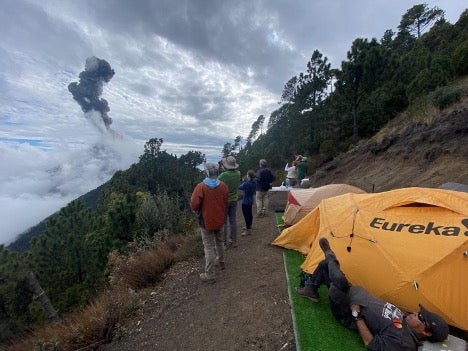
Uncrewed Aerial Systems (UAS), or drones, are changing the way volcano scientists do their job. UAS provide unmatched perspectives and access to the harshest environments on the planet while limiting human exposure to those hazards. Never before have we been able to stare down the gullet of an explosive volcano from relative safety. UAS have expanded the ability to collect more than just visual data, too.
Many scientists are strapping lightweight sensors of all kinds to UAS in an attempt to push the envelope a little bit further. Boise State staff and geophysics alum Jerry Mock is at the forefront of UAS-based observations of volcanic activity.
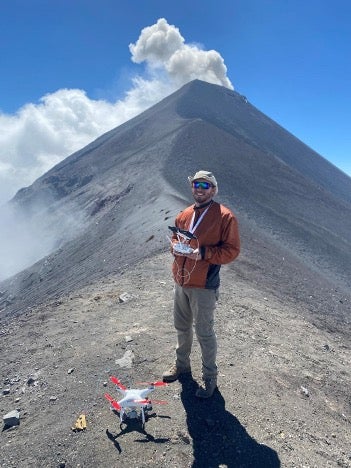
Mock, with help from collaborators at Boise State’s infrasound lab, spearheaded a project he lovingly coined “Operation Gem Drop.” The Gem is an inexpensive infrasound sensor produced in-house by Research Professor Jake Anderson. These infrasound sensors are sensitive to sounds below 20 Hz, which are produced energetically by volcanoes, but are below the range of human hearing.
Mock’s goal of UAS-delivered infrasound monitoring was to get as close as possible to the source of these powerful signals, which at Fuego Volcano have been known to rattle and break windows 8 km (5 miles) away.
To get sensors close, Mock used a Phantom 4 UAS equipped with a special payload release system originally intended for fishermen to cast further with a drone assist. Instead of bait on the end of the 5m fishing line, there was a 3D printed cage co-designed by Boise State student Owen Walsh. In Feb. 2024 Mock successfully deployed 2 Gems, one directly on the crater and another 500 m away, still well within the red (no-go) zone. The crater sensor was exploded before it could be recovered, however the other sensor was successfully retrieved and recorded the largest blast from the volcano during a five-day field campaign.
View footage and infrasound data of the active Fuego Volcano, collected by Jerry Mock.
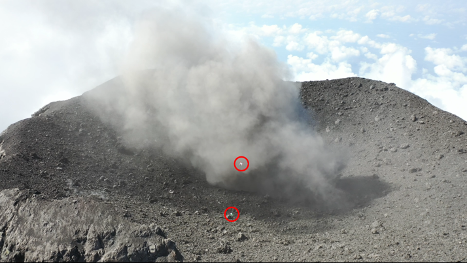
“Jerry Mock is an incredible drone pilot and managed to collect spectacular footage,” said geophysics professor Jeffrey Johnson. “Not only that, but these detailed videos allow us to better understand the infrasound signals we are collecting.”
Mock combined “Operation Gem Drop” with other UAS-focused work. He worked closely with colleagues from Italy as well as collaborators Armando Pineda and Roberto Merida from Guatemala.
During the field campaign, Mock and partners successfully flew several missions to capture the moment when the volcano erupts strongly enough to create a visible shockwave and throw red hot bombs of molten rock hundreds of meters in the air.
They also flew missions to create 3D reconstructions of Fuego’s crater and its flanks for comparison with older digital elevation models, to monitor the evolution of the cone over time. He became an expert in these map-making skills while working toward his masters degree in geophysics, received at Boise State in December 2023.
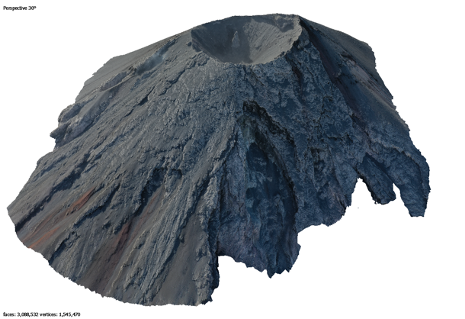
Mock was also in Guatemala to present his work and lead a UAS workshop focused on volcano science applications at the Cities on Volcanoes 12 conference. This meeting was organized as a joint effort between Guatemalan collaborators and Boise State, led by Johnson. This conference was the held for the first time in Central America, and was also the first time fully bilingual.
Faculty and staff from Boise State attending the meeting include adjunct faculty Manuel Gomez-Navarro, geoscience professor Brittany Brand, doctoral candidate Ashley Bosa, and Johnson, who were all presenters at the meeting in colonial Antigua, Guatemala, a world heritage site. Seven hundred international participants attended Cities on Volcanoes in Guatemala, which is the foremost meeting for the intersection between volcanoes and society.
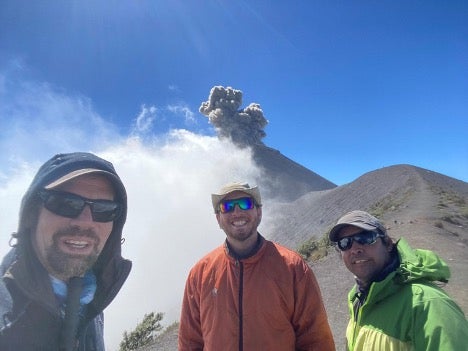
-Written and photographed by Jeffrey Johnson